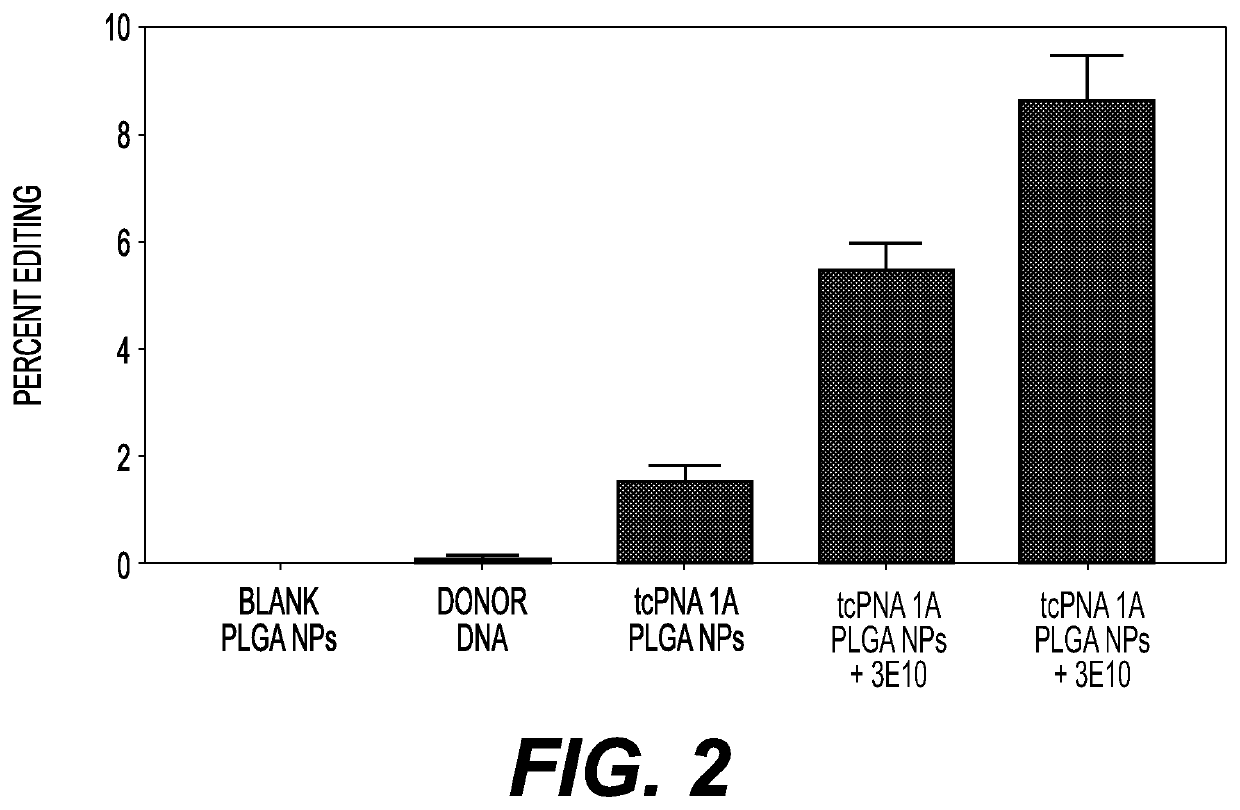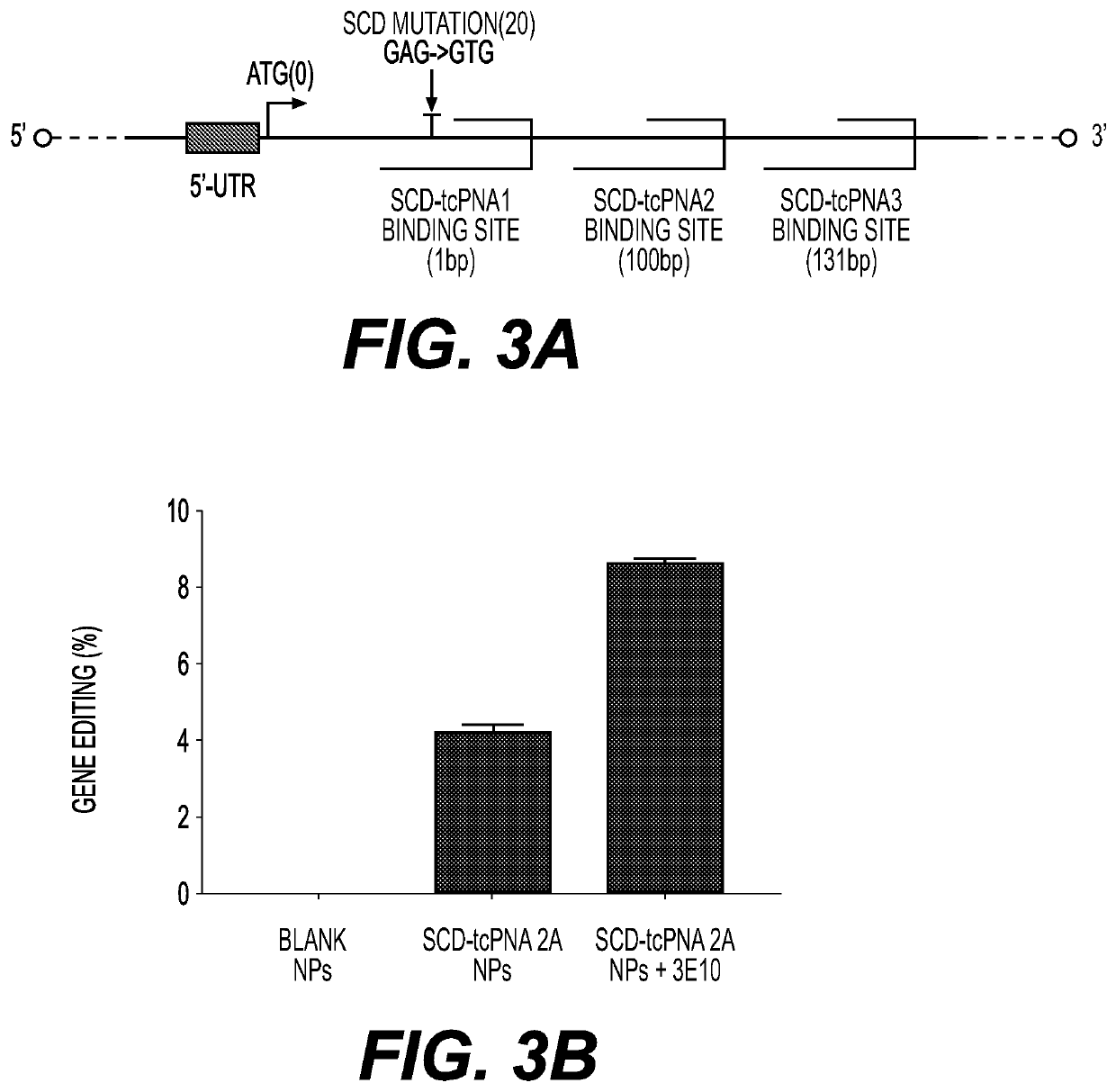Compositions and methods for enhancing triplex and nuclease-based gene editing
a technology of nuclease and compound, applied in the field of compound and method for enhancing triplex and nuclease-based gene editing, can solve the problem of low efficiency of gene modification, and achieve the effect of reducing or low off-target modification
- Summary
- Abstract
- Description
- Claims
- Application Information
AI Technical Summary
Benefits of technology
Problems solved by technology
Method used
Image
Examples
example 1
ckdown Enhances PNA-Mediated Gene Editing in K562 Cells
Materials and Methods
[0374]PNA and Donor DNA
[0375]The sequence of the triplex forming PNA (designated PNA194) was
(SEQ ID NO: 45)H-KKK-JJTJTTJTT-O-O-O-TTCTTCTCC-KKK-NH2,
where, J=pseudoisocytosin, K=lysine, and O=flexible octanoic acid linker.
[0376]The single-stranded donor DNA oligomer was prepared by standard DNA synthesis and 5′ and 3′-end protected by inclusion of three phosphorothioate internucleoside linkages at each end. The sequence of the donor DNA was
(SEQ ID NO: 46)5′GTTCAGCGTGTCCGGCGAGGGCGAGGTGAGTCTATGGGACCCTTGATGTTT 3′ (51 nucleotides).
[0377]Cell Culture and Treatment
[0378]A cell culture model of human K562 cells was used. These cells carry a β-globin / GFP fusion transgene consisting of human β-globin intron 2. carrying a thalassemia-associated IVS2-I (G→A) mutation embedded within the GFP coding sequence, resulting in incorrect splicing of β-globin / GFP mRNA and lack of GFP expression (Chin, et al., Proc Natl Acad Sci ...
example 2
nces Editing of the Beta Globin Gene Both Ex Vivo and In Vivo Using the β-Globin / GFP Mouse Model
[0383]Materials and Methods
[0384]PNA and Donor DNA
[0385]The single-stranded donor DNA oligomer was prepared by standard DNA synthesis and 5′ and 3′-end protected by inclusion of three phosphorothioate internucleoside linkages at each end. The sequence of the donor DNA matches positions 624 to 684 in β-globin intron 2 and is as follows, with the correcting IVS2-654 nucleotide underlined:
(SEQ ID NO: 47)5′AAAGAATAACAGTGATAATTTCTGGGTTAAGGCAATAGCAATATCTCTGCATATAAATAT3′
[0386]The sequence of the PNA (designated γtcPNA4) was H-KKK-JTTTJTTTJTJT-OOO-TCTCTTTCTTTCAGGGCA-KKK-NH2 (SES ID NO:48), where the underlined nucleobases have a gamma mini-PEG side chain substitution, J=pseudoisocytosine, K=lysine, and O=flexible octanoic acid linker.
[0387]Nanoparticle Synthesis
[0388]The polymeric PLGA nanoparticles used to deliver the gene editing agents were synthesized by a double-emulsion solvent evaporation ...
example 3
nces PNA / DNA Mediated Editing of the Beta Globin Gene in MEFs from a Mouse Model of Sickle Cell Disease
Materials and Methods
[0399]PNA and Donor DNA
[0400]The sequence of the PNA (designated tcPNA1A) was H-KKK-JJTJTTJ-OOO-CTTCTCCACAGGAGTCAG-KKK-NH2 (SEQ ID NO:49) where the underlined nucleobases have a gamma mini-PEG side chain substitution, J=pseudoisocytosine, K=lysine, and O=flexible octanoic acid linker.
[0401]The single-stranded donor DNA oligomer was prepared by standard DNA synthesis and 5′ and 3′-end protected by inclusion of three phosphorothioate internucleoside linkages at each end. The sequence of the donor DNA was
(SEQ ID NO: 50)5′TTGCCCCACAGGGCAGTAACGGCAGACTTCTCCTCAGGAGTCAGGTGCACCATGGTGTCTGTTTG-3′.
[0402]Mouse Model for Sickle Cells Disease
[0403]In sickle cell disease (SCD), the mutation (GAG->GTG) at codon 6 results in glutamic acid changed to valine. For correction (editing) of this SCD mutation site, studies were performed in the Townes mouse model.
[0404]The Townes mouse...
PUM
| Property | Measurement | Unit |
|---|---|---|
| composition | aaaaa | aaaaa |
| peptide nucleic acid | aaaaa | aaaaa |
| pharmaceutical composition | aaaaa | aaaaa |
Abstract
Description
Claims
Application Information
 Login to View More
Login to View More - R&D
- Intellectual Property
- Life Sciences
- Materials
- Tech Scout
- Unparalleled Data Quality
- Higher Quality Content
- 60% Fewer Hallucinations
Browse by: Latest US Patents, China's latest patents, Technical Efficacy Thesaurus, Application Domain, Technology Topic, Popular Technical Reports.
© 2025 PatSnap. All rights reserved.Legal|Privacy policy|Modern Slavery Act Transparency Statement|Sitemap|About US| Contact US: help@patsnap.com



